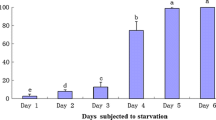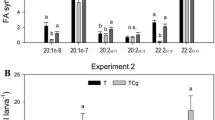Abstract
During a period of short-term (19 d) starvation, total lipid in the digestive gland of Euphausia superba Dana decreased from 21 to 9% dry weight. Total lipid per digestive gland decreased significantly during starvation compared to Day 0 individuals, falling from 1960 (±172) to 385 (±81) μg. Polar lipid was the major lipid class utilised during starvation, falling from 1510 (±225) to 177 (±46) μg per digestive gland (76 to 45%). Absolute levels of triacylglycerol fell from 300 (±41) to 76 (±5) μg; however, relative levels remained unchanged. The relative level of free fatty acid increased significantly with starvation (4 to 39%) with absolute levels ranging from 79 (±1) to 156 (±20) μg per digestive gland. Absolute levels of all fatty acids per digestive gland declined continually until the end of the starvation period. The long-chain polyunsaturated acids eicosapentaenoic (20:5ω3) and docosahexaenoic (22:6ω3), decreased with starvation from 37 to 26% and 15 to 10%, respectively whereas the saturated fatty acid, palmitic acid (16:0), increased from 15 to 20%. Cholesterol, the major sterol in this organ, increased from 17 (±20) to 44 (±13) μg per digestive gland by Day 3, and by Day 19 had returned to levels found in the digestive gland of Day 0 individuals. Desmosterol followed a similar pattern to cholesterol, increasing from 3 (±1) μg per digestive gland on Day 0 to 11 (±4) μg on Day 3, and falling to 2 (±1) μg on Day 19. Other sterols in the digestive gland, predominantly of algal origin, fell from the levels found in Day 0 individuals to near zero amounts by Day 6. The digestive gland of E. superba plays a dynamic role during shortterm starvation in terms of lipid content and composition. The relative levels of polar lipids, free fatty acids and cholesterol in the digestive gland may provide reliable indices of the nutritional condition of E. superba in the field. Sterols in the digestive gland are indicative of recent dietary composition of krill, and may also be used to quantify dietary input from individual phytoplanktonic species.
Similar content being viewed by others
References
Bligh, E. G., Dyer, W. J. (1959). A rapid method of total lipid extraction and purification. Can. J. Biochem. Physiol. 37: 911–917
Dall, W., Chandumpai, A., Smith, D. M. (1992). Fatty acid composition of organs and tissues of the tiger prawn Penaeus esculentus during the moulting cycle and during starvation. Mar. Biol. 113: 45–55
Dall, W., Moriarty, D. J. W. (1983). Function aspects of nutrition and digestion. In: Mantel, L. H. (ed.) The biology of Crustacea. Vol 5. Academic Press, New York, p. 215–262
Hagen, W., (1988). Zur Bedeutung der Lipide im antarktischen Zooplankton. [On the significance of lipids in Antarctic zooplankton]. Ber. Polarforsch. (Bremerhaven) 49: 1–129
Ikeda, T., Dixon, P. (1982). Body shrinkage as a possible over-wintering mechanism of the Antarctic krill, Euphausia superba Dana. J. exp. mar. Biol. Ecol. 62: 143–151
Nemoto, T. (1986). Chlorophyll pigments in the stomachs of euphausiids. J. oceanogr. Soc. Japan 17: 50–55
Nichols, P. D., Jones, G. J., de Leeuw, J. W., Johns, R. B. (1984). The fatty acid sterol composition of two marine dinoflagellates. Phytochem 23: 1043–1047
Nichols, D. S., Nichols, P. D., Sullivan, C. W. (1993). Seasonal studies of the fatty acid, sterol and hydrocarbon composition of Antarctic sea-ice diatom communities collected during the spring bloom of 1989 in McMurdo Sound. Antarctic Sci. (in press)
Nichols, P. D., Palmisano, A. C., Rayner, M. S., Smith, G. A., White, D. C. (1989). Changes in the lipid composition of Antarctic sea-ice diatom communities during a spring bloom: an indication of community physiological status. Antarctic Sci. 1: 133–140
Nichols, P. D., Palmisano, A. C., Smith, G. A., White, D. C. (1986). Lipids of the Antarctica sea ice diatom Nitzschia cylindrus. Phytochem. 25: 1649–1653
Nichols, P. D., Skerratt, J. H., Davidson, A., Burton, H., McMeekin, T. A. (1991). Lipids of cultured Phaeocystis pouchetii: signatures for food-web, biogeochemical and environmental studies in Antarctica and the Southern Ocean. Phytochem. 30:3209–3214
Nicol, S., Stolp, M., Cochran, T., Geijsel, P., Marshall, J. (1992). Summer growth and shrinkage of Antarctic krill Euphausia superba from the Indian Ocean sector of the Southern Ocean during Summer. Mar. Ecol. Prog. Ser. 89: 175–181
Quentin, L. B., Ross, R. M., Clark, A. (1993). Krill energetics: seasonal and environmental aspects of the physiology of Euphausia superba. In: El-Zayed (ed.) Southern Ocean ecology, the BIOMASS prospective. Cambridge University Press, Cambridge, England (in press)
SAS Institute, Inc. (1988). Statistical guide for personal computers. Users' guide: Release 6.03 edn. SAS/STATTM Institute Inc., Cary, North Carolina
Shuman, F. R., Lorenzen, C. J. (1975). Quantitative degradation of chlorophyll by a marine herbivore. Limnol. Oceanogr. 20: 580–586
Strain, H. H., Svec, W. A., Aizetmuller, K., Grandolfo, M. C., Katz, T. T., Kjosen, H., Norgard, S., Liaaen-Jensen, S., Haxo, F. T., Wegafahrt, P., Rapoport, H. (1971). The structure of peridinin, the characteristic dinoflagellate carotenoid. J Am. chem. Soc. 93: 1823–1824
Stryer, L. (1988). Biochemistry. 3rd edn. W. H. Freeman & Co., New York, N.Y.
Teshima, S., (1982). Sterol metabolism. In: Pruder, G. D., Langdon, C. J., Conklin, D. E. (eds.) Proceedings of the Second Conference on Aquaculture Nutrition. Biochemical and physiological approaches to shellfish nutrition. Louisiana State University Press, Baton Rouge, p. 205–215
Teshima, S., Kanazawa, A. (1980). Transport of dietary lipids and role of serum lipoproteins in the prawn. Bull. Jap. Soc. scient. Fish. 46: 51–55
Virtue, P., Nichols, P. D., Nicol, S., McMinn, A., Sikes, E. L. (1993). The lipid composition of Euphausia superba Dana in relation to the nutritional value of Phaeocystis pouchetii (Hariot) Lagerheim. Antarctic Sci. 5: 169–177
Volkman, J. K., Everitt, D. A., Allen, D. I. (1986). Some analyses of lipid classes in marine organisms, sediments and seawater using thin-layer chromatography-flame ionisation detection. J. Chromat. 6:147–162
Volkman, J. K., Jeffrey, S. W., Nichols, P. D., Rogers, G. I., Garland, C. D. (1989). Fatty acid and lipid composition of 10 species of microalgae used in mariculture. J. exp. mar. Biol. Ecol. 128: 219–240
Volkman, J. K., Nichols, P. D. (1991). Applications of thin layer chromatography-flame ionization detection to the analysis of lipids and pollutants in marine and environmental samples. J. Planar Chromat. 4:19–26
White, D. C., Davis, W. M., Nickels, J. S., King, J. D., Bobbie, R. J. (1979). Determination of the sedimentary microbial biomass by extractable lipid phosphate. Oecologia 40:51–62
Wright, S. W., Jeffrey, S. W. (1987). Fucoxanthin pigment markers of marine phytoplankton analysed by HPLC and HPTLC. Mar Ecol. Prog. Ser. 38: 259–266
Author information
Authors and Affiliations
Rights and permissions
About this article
Cite this article
Virtue, P., Nicol, S. & Nichols, P.D. Changes in the digestive gland of Euphausia superba during short-term starvation: lipid class, fatty acid and sterol content and composition. Marine Biology 117, 441–448 (1993). https://doi.org/10.1007/BF00349320
Received:
Accepted:
Issue Date:
DOI: https://doi.org/10.1007/BF00349320




